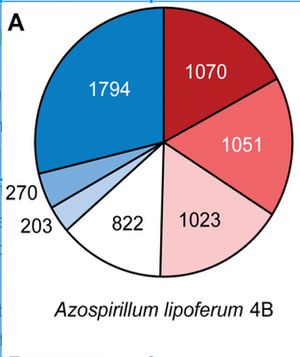Azospirillum lipoferum
Introduction
Azospirillum lipoferum, is a free living, gram positive, plant-growth-promoting a-proteobacteria, capable of affecting the growth and yield of numerous plant species, many of agronomic and ecological significance.
The leading theory concerning its growth promotion capacity lies in its ability to produce various phytohormones that improve root growth, adsorption of water and minerals that eventually yield larger, and in many cases more productive plants (Dobbelaere et al. 2001)The organism was first described by Martinus Beijerinck who named it Spirillum lipoferum , in 1925. Later, the classification was revised by Tarrand et al. who renamed it Azospirillum lipoferum which means "small, fat bearing, spiral".
Classification
Domain: Bacteria
Phylum: Proteobacteria
Class: Alphaproteobacteria
Order: Rhodospirillales
Family: Rhodospirillaceae
Genus: Azospirillum
Species: Azospirillum lipoferum
Ecology
Azospirillum lipoferum colonizes root plants forming a symbiotic Relationship where the plant benefits through N2 fixation, phytohormones, and hormone balance.
The association with A. lipoferum promotes the elongation of plant roots.
Constant genome rearrangements promotes population diversity leading as a escape mechanism to bypass host defenses.
Genome
Genome size of 6,846,400 bp
GC content: 67.7%
CDS of 6,094
Contains 1 chromosome and several plasmids (range: 40-550 kbp)
Many replicons with many being chromids (chromosome + plasmid)
Shares many genes with aquatic species which might be explained by evolutionary transition from marine to terrestrial environments.
Scientists suggests that the transition was possible due to horizontal gene transfer promoted by conjugation and transduction.
Economic Significance
Legumes that have been inoculated with growth promoting bacteria can contribute with 50 to 300 pounds of nitrogen per acre in the soil. This nitrogen helps increasing the yield and lower fertilizer costs by the biological fertilization it provides making it environmentally safe and user safe.
"Inoculating soybeans is a very profitable practice. Although the results have not always been positive, the long-term result is a profit of over 300 percent. For most inoculation products, a yield increase of half a bushel per acre profitable and yield increases of 2 to 7 bu/ac have been common." Dr. Jim Beuerlein Dept. of Horticulture and Crop Science Retired, Ohio State University
Reference
http://www.genoscope.cns.fr/spip/-Azospirillum-lipoferum-.html
http://www.plantphysiol.org/content/125/4/2053.full
http://en.wikipedia.org/wiki/Rhizobacteria
http://www.idosi.org/aejaes/jaes8(6)/1.pdf
http://www.bacterio.net/azospirillum.html
http://www.straininfo.net/taxa/308;jsessionid=B15A4846847631CCCC748BDC2391FB0A.straininfo2
http://www.ncbi.nlm.nih.gov/Taxonomy/Browser/wwwtax.cgi?mode=Info&id=193




